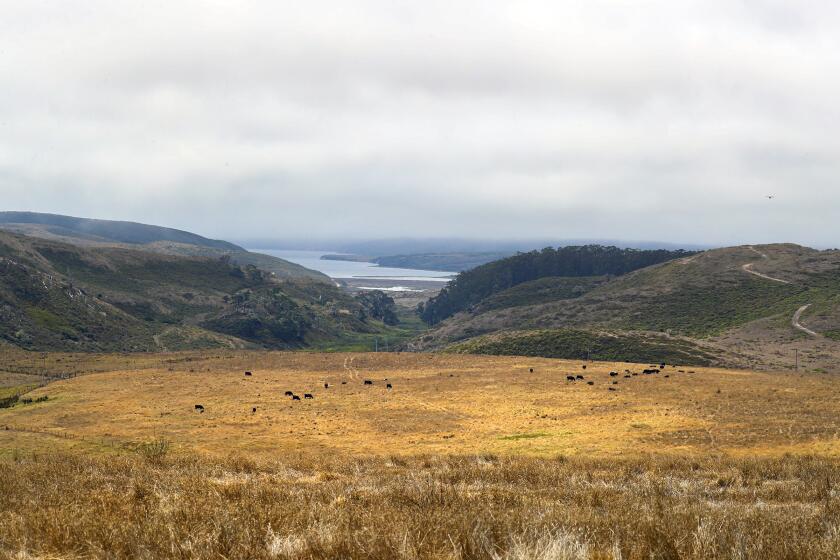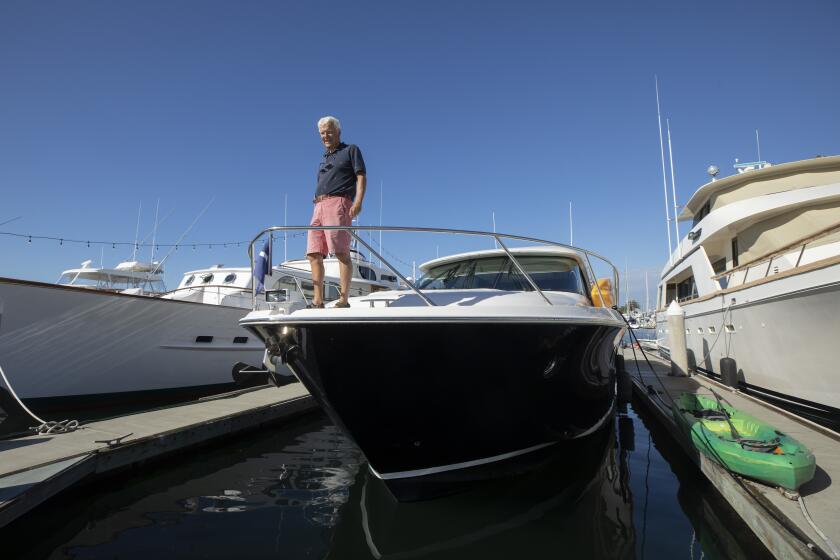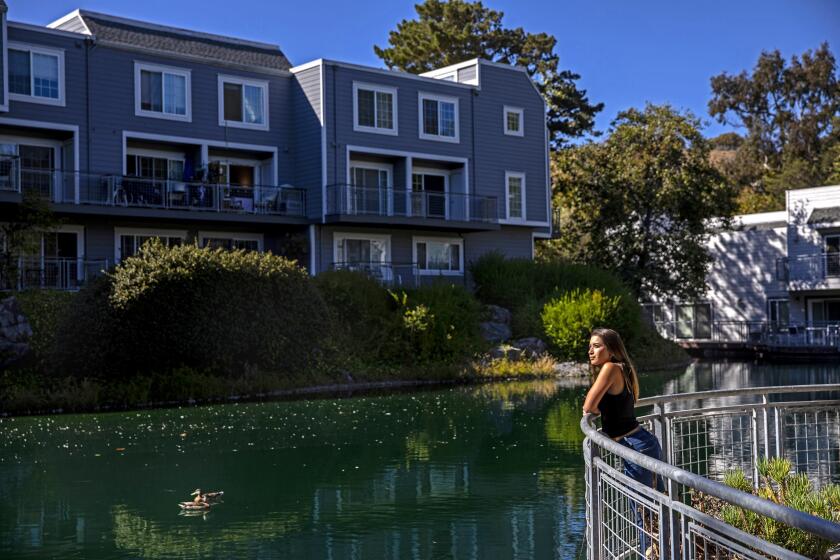They live rent-free on San Francisco Bay. But now their ‘floating homeless encampment’ faces extinction
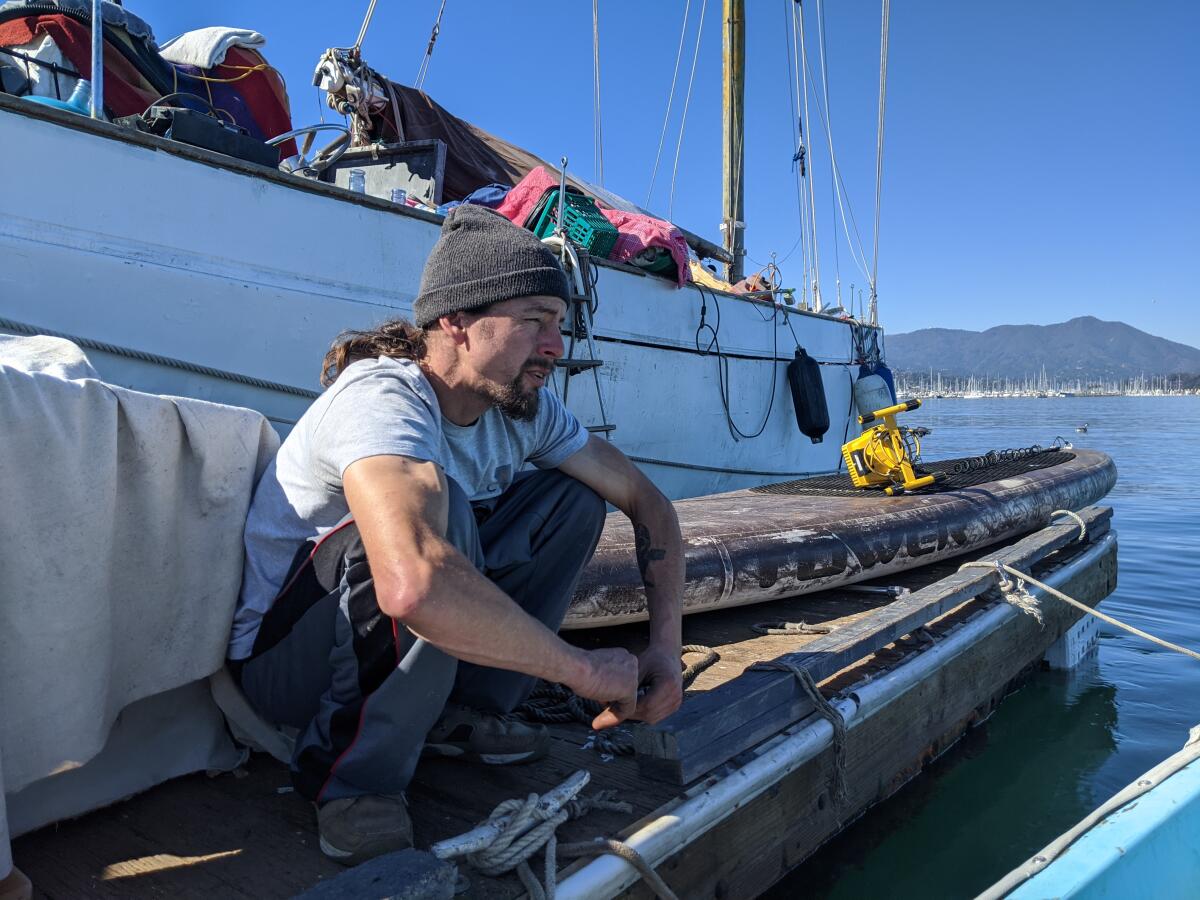
- Share via
ON RICHARDSON BAY — Greg Baker likes to say that the only way he’s leaving his home, a broken-down 40-foot sailboat anchored in this sparkling estuary north of the Golden Gate Bridge, is in handcuffs or a black plastic bag.
“I like the peace, the quiet — if I stub my toe I can holler,” said Baker, who at 82 has been living here, in one vessel or another, for half a century.
Lately though, life has been anything but peaceful on the bay. Baker and his fellow anchor-outs, as they’re known, have long lived illegally and rent-free in the sightline of some of America’s priciest real estate, and now authorities in Sausalito and other neighboring communities want them gone. The battle has pitted the forces of gentrification against Sausalito’s fading identity as a freewheeling maritime town that has always been a refuge for rebels and dropouts.
Around 90 vessels in various states of disrepair bob amid the seagulls and paddle-boarders. To the flinty salts who occupy these rusting tugboats and de-masted sloops, Richardson Bay is sacred, a last bastion of living free on the water in a Bay Area of Apple Stores and $3,000-a-month studio apartments.
“It’s not that I don’t like Disneyland,” Baker said. “I just don’t want everything to look like Disneyland.”
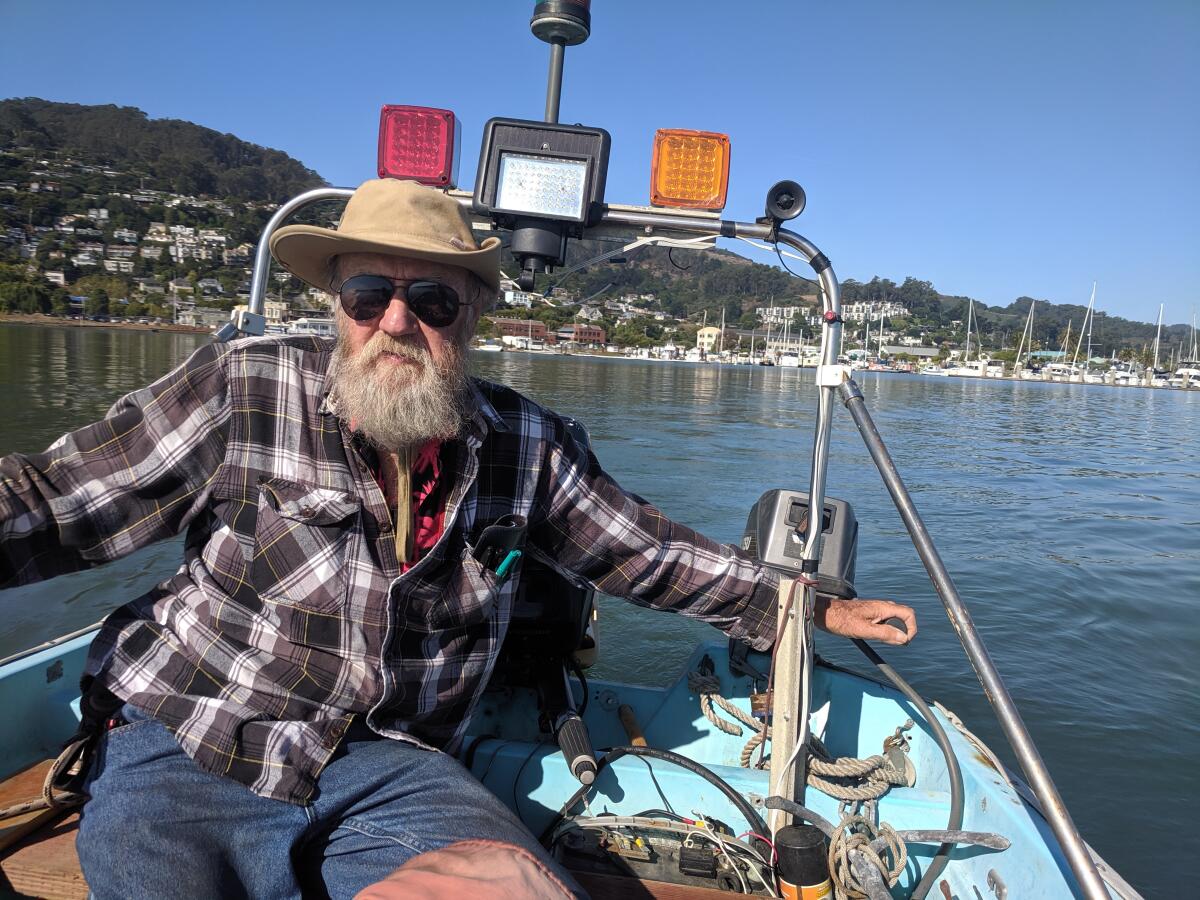
But officials say they have looked the other way for decades as anchor-outs spewed fuel, sewage and other hazardous materials into the bay. In recent years, the environmental damage worsened along with crime and accidental deaths on the water, as California’s housing crunch drove scores of people with little or no boating experience into unseaworthy vessels bought cheap on the internet.
Gov. Gavin Newsom is emphasizing holding cities accountable for state laws on zoning and approving housing projects, including starting a new effort staffed with more than dozen employees to enforce the rules.
In August, following years of controversy, officials announced a five-year plan to clear what they describe as a floating homeless encampment.
“The bay is everyone’s front yard,” said Lawrence Goldzband, who heads the San Francisco Bay Conservation and Development Commission. “You can’t build a football stadium or a shopping mall on it. And you can’t live on it.”
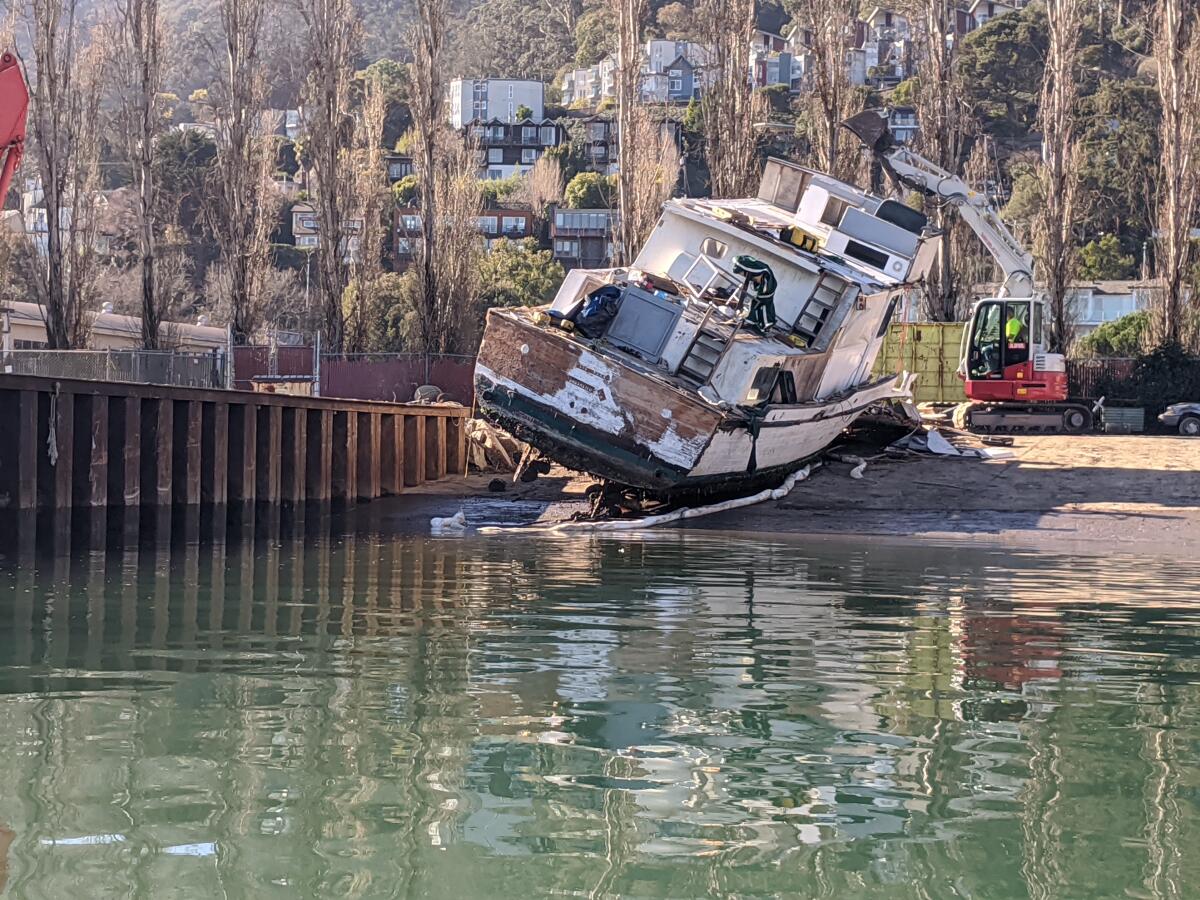
The situation has become increasingly bitter, resulting in crushed boats and standoffs with police. Last spring, several mariners accused authorities of standing by while one man’s boat burned, ending in the death of his pit bull puppy, Runt Girl.
Curtis Havel, who until recently was the harbormaster overseeing the anchorage, has been threatened, sued and pepper sprayed. Last year, a small group of anchor-outs staged a protest on his front lawn.
From shore, people see the boats float like paper hats on the glassy green surface of Richardson Bay “and they get all misty-eyed and dreamy,” Havel said.
But up close, he said, many of the boats are piled so high with old furniture, suitcases and machine parts that they appear to be slowly disintegrating into the bay. Few have propulsion or steering.
“And if they sink, God help us, it’s a little environmental disaster,” Havel said.
The harbormaster spent most days patrolling the estuary on a 21-foot aluminum landing craft. Depending on whom you ask, he was either cleaning up a vital natural resource or making poor people homeless.
::
A couple of years ago, Baker and a few other longtime mariners formed the Richardson Bay Special Anchorage Assn., which aimed to improve the image of the anchor-outs by encouraging newcomers to do things like buy life jackets, pump out their toilets, and secure their anchors before winter, when unpredictable winds and waves often set improperly moored vessels adrift.

“The summers are gravy, but the winters are no joke,” said Kristina Weber, a friend of Baker’s who moved onto the bay in 2018 with her two dogs, Baxter and Poseidon, after seeing an ad for an affordable boat on Craigslist.
A freelance landscaper, Weber believed she had found a solution to the impossibly high rents in Marin County. But that boat caught fire and was a total loss. Her next two boats sank.
Another year of drought has water managers taking extraordinary measures to keep faucets flowing.
Now the 42-year-old is negotiating a move onto a fourth vessel that’s situated near Baker.
“It’s a tight-knit little community,” she said. “You have to look out for each other out on the water.”
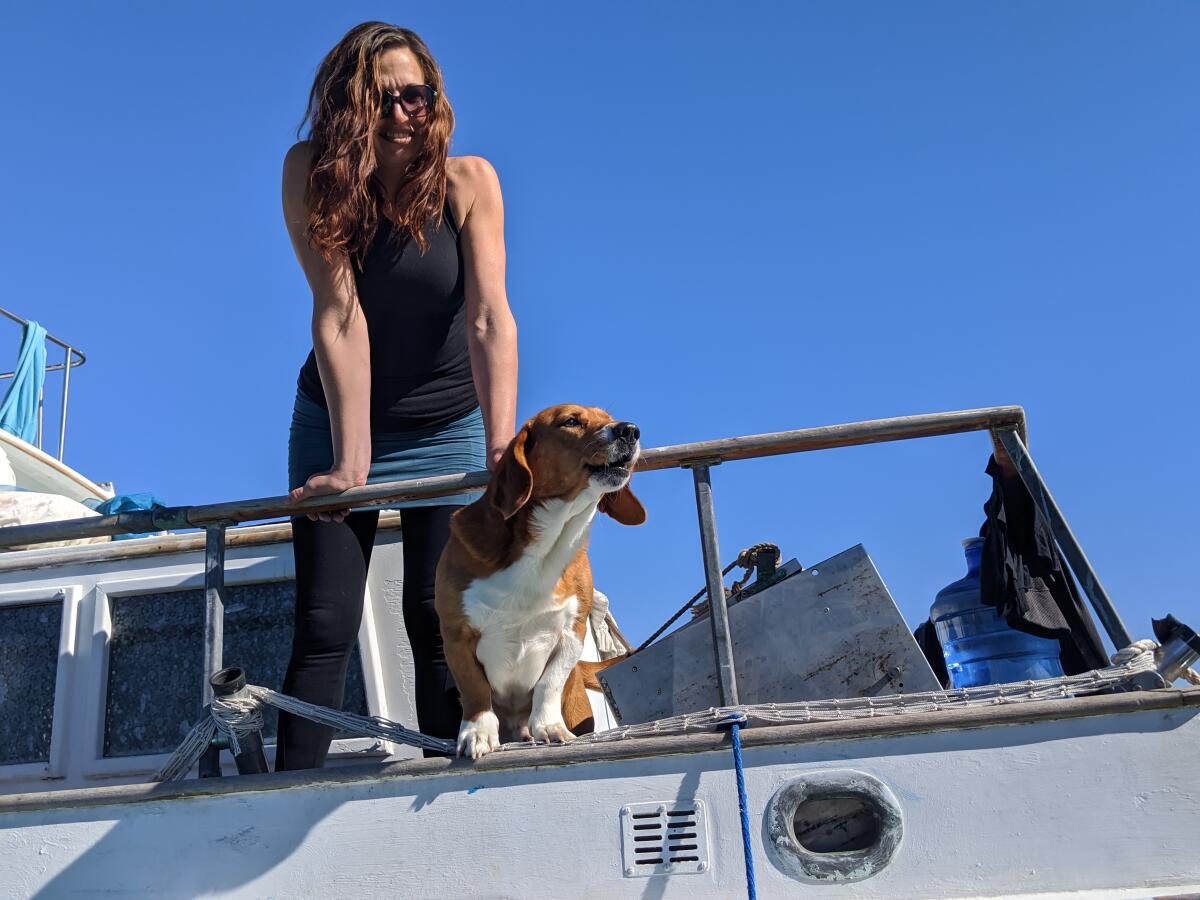
Baker has an established reputation on the Sausalito waterfront as a Good Samaritan, which is the title he has printed on his business cards. It goes back to the days when he patrolled the bay in a 24-foot tugboat called the Tug Kent he rigged for volunteer firefighting and rescue duties.
Though he rarely goes out on calls anymore, he keeps the marine and fire scanners on while he tinkers with parts for his boat, his collection of old clocks or whatever other treasures he manages to find on land dumpster diving.
Baker’s boat, the C.A. Marcy, is named after the grandfather of the boat maker who built it in Sausalito in the late 1970s, on a spot that now holds tennis courts. It’s equipped with a gas generator that powers a microwave, a toaster and an electric blanket. Solar panels run the lights. Baker keeps his food cool in a chest stuffed with blue ice packs he refreezes every few days on land.
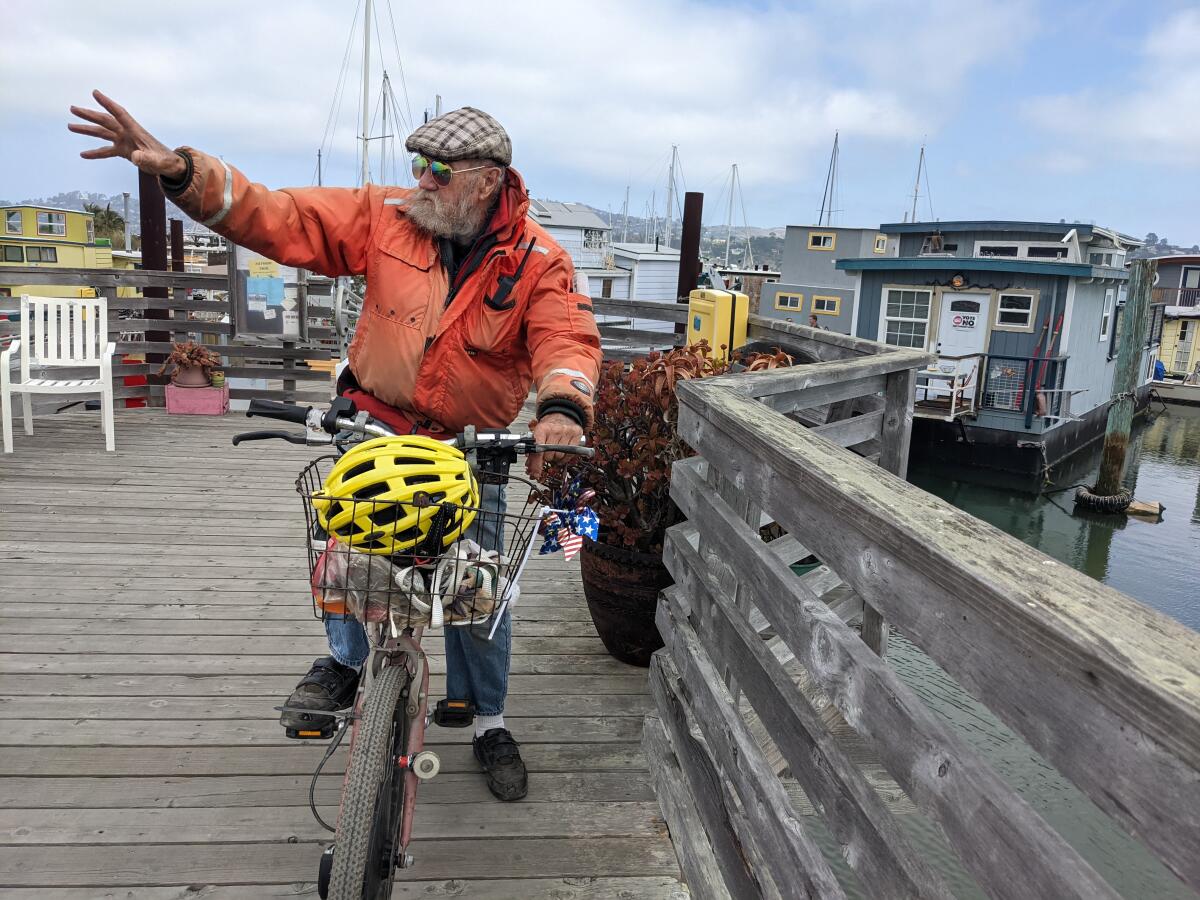
Amid the antique timepieces cluttering the walls of the cabin hang two black-and-white photos: One is a portrait of Baker’s great-great grandfather, a Nova Scotia sea captain with a long gray beard, like his own. The other is the C.A. Marcy in her youth, sails billowing.
Most evenings, Baker unties his blue dinghy and motors the 500 feet or so to shore, where he showers and checks his email at a property management company that pays him $800 a month to work as a part-time security guard. (Most boats are anchored farther out than Baker’s.)
Before the pandemic, the Richardson Bay Special Anchorage Assn. held a couple of meetings. But Baker said they were overrun by “rabble-rousers,” and the group never got off the ground.
“It was like herding cats,” he said, adding by way of explanation: “Some of the people out here are here because they can’t get along anywhere else.”
::
The conflict on the bay has its roots in a class rivalry that goes back to the 19th century, when wealthy San Franciscans built summer homes with breathtaking views on the surrounding hills while Chinese merchants and Portuguese boatbuilders settled the working-class waterfront.
That tension between the “hill snobs” and the “wharf rats” escalated after World War II, when the owner of Marinship, the town’s newly defunct shipyard, invited people to move into retired steam ferries and decaying barges he had dragged onto the mud flats.
“In Sausalito, people live on anything that floats,” read a 1951 article in the San Francisco Chronicle.
Artists and bon vivants lived side by side with Hells Angels and characters with names like Green Death and Captain Garbage. Packs of wild dogs and barefoot children explored at low tide, and a pirate-themed band called The Redlegs played all-night parties in a decommissioned ferry named the Charles van Damme.
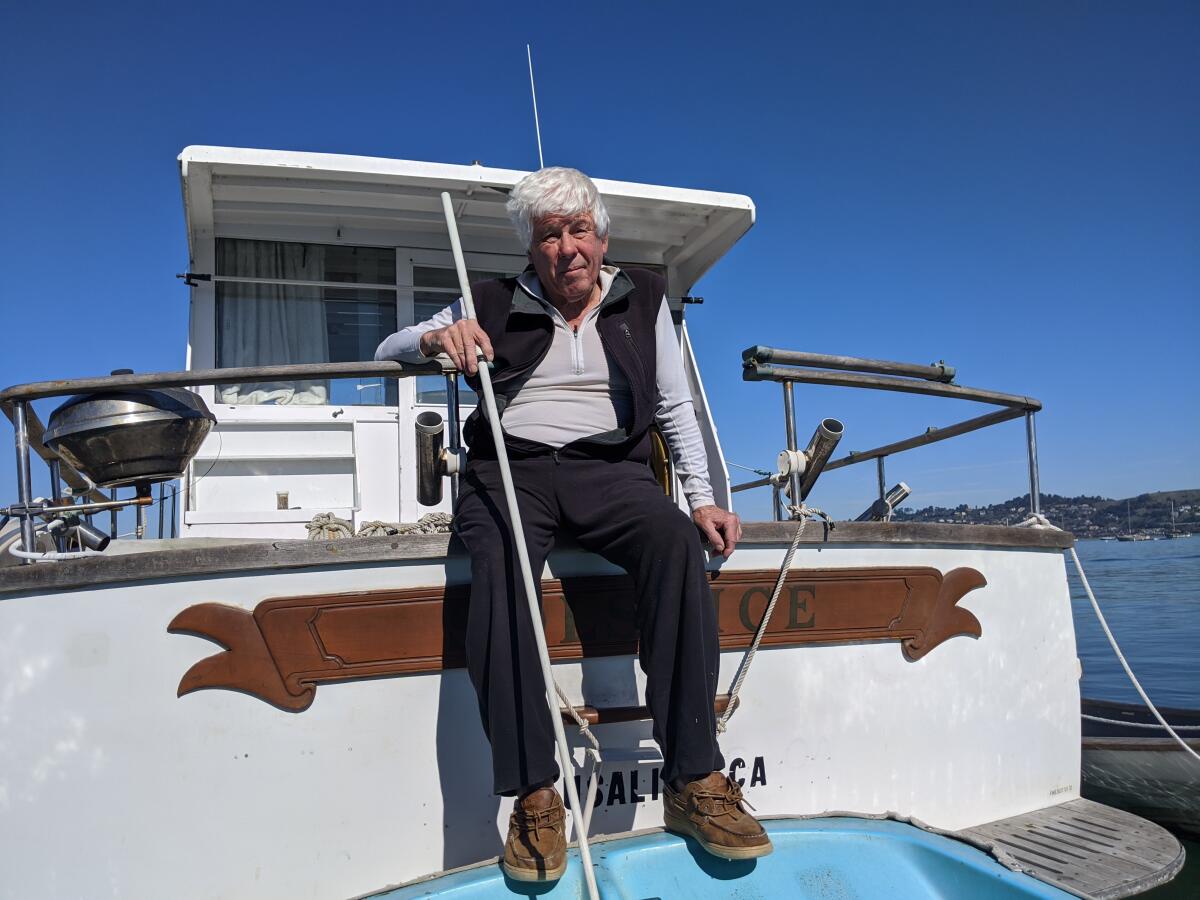
But by the 1970s, an uptick in drugs and guns prompted hillside residents to push for an end to the free-for-all on the wharf. A plan to build high-rise condominiums eventually sparked the Houseboat Wars, a series of legal battles and violent confrontations that raged for a decade. In a compromise, developers abandoned plans to build luxury housing on the harbor, while houseboats moved into designated marinas and complied with municipal and environmental codes.
Boat dwellers who wouldn’t or couldn’t follow the new rules moved on land or took to the open waters of the bay, where a new defiant community of live-aboards appointed themselves the true outsider-citizens of the waterfront.
Baker was just out of the Navy in 1963 when he drove north from San Diego and took up residence among some 20 other vessels in a metal lifeboat equipped with a mattress and a wood stove.
“You had to be careful when you were sleeping not to burn your feet,” he said.
“It’s not that I don’t like Disneyland. I just don’t want everything to look like Disneyland.”
— Greg Baker
In 1987, with harbors up and down California cracking down on the growing numbers of people squatting in boats, local officials imposed a 72-hour limit on vessels dropping anchor in Richardson Bay.
But sporadic efforts to enforce the law were met with lawsuits from the mariners and protests from the public. Land dwellers occasionally grumbled that the rundown vessels were an eyesore or got angry when a runaway craft collided with someone’s shorefront property. Mostly, they looked out at the boats bobbing on the bay and saw them as a romantic vestige of “a colorful past, a diversity of life and a tradition of mariners living on their vessels,” as one anchor-out told a Chronicle reporter in 2001.
Over the last decade, the state’s housing crisis has driven even more people onto the water. In addition, when harbors around the San Francisco Bay began cracking down on squatters in boats — in part due to pressure to clear the waters for the 2013 America’s Cup sailboat race — many of them moved to Richardson Bay.
By 2015, its anchor-out population had nearly tripled compared with a decade earlier.

In Sausalito, which long ago replaced its decrepit party boats and waterfront tiki studios with manicured marinas and super-yachts, complaints mounted about problems ranging from trash and raw sewage dumped in the bay to thefts, vandalism, floating drug labs and homicides.
Yacht brokers say demand is through the roof, with little to no inventory and multi-month wait lists.
In response authorities began slapping bright orange warning stickers on illegally anchored vessels and eventually impounding and crushing the worst examples of “marine debris.”
But it was the state that finally forced the issue with a scathing 2019 audit of the San Francisco Bay Conservation and Development Commission, which was founded in the 1960s to protect the bay against indiscriminate development and pollution.
Citing the lax enforcement of the illegally moored vessels on Richardson Bay as the prime example of how the watchdog agency had failed to do its job, the report said it had “harmed a delicate ecosystem” by allowing the anchor-outs to flout the law for decades “because the issue is highly political and involves concerns about displacing residents.”
The last straw was mounting evidence presented by environmentalists that the anchors and chains of the live-aboards had destroyed as much as 40% of the eelgrass that grows on the floor of the shallow estuary and provides a critical habitat for birds and fish.
Threatened with a lawsuit if they didn’t start enforcing their own rules, local officials agreed to a phased plan to clear the bay of anchor-outs by late 2026.
“Nobody likes change,” said Havel, the harbormaster, who has cleared and crushed about 120 derelict crafts in the last two years, most of them unoccupied. He has also pulled up bicycles, generators, suitcases and old refrigerators dripping with seaweed from the bottom of the bay.
His employer, the Richardson Bay Regional Agency, has contracted with nonprofits to try to connect the live-aboards with alternative shelter on land.
So far, they’ve had little success. But in keeping with Sausalito history, some of the displaced mariners have decided to make a last stand on the waterfront.
Last December, an elderly former anchor-out who had lost his boat pitched a tent near Dunphy Park, a waterfront patch of grass with a gazebo where Sausalito holds its annual Fourth of July chili cookoff. Others who had been forced off the water joined him, as did a handful of people who’d been sleeping under freeways in neighboring cities. Soon Camp Cormorant, as they called it, had about 35 members.
Whether the homeless encampment — and the anchor-outs, for that matter — were victims of an intolerant society that respects only wealth or a bunch of freeloaders has been hotly debated in Sausalito, a tourist magnet known for its art galleries and upscale bistros.
After months of legal wrangling, a federal judge gave the city permission to move the encampment to a less visible location less than a mile away.
On a sunny morning in June, police arrived with a bulldozer and dismantled several tiny houses and a vegetable garden, while anchor-outs banged drums and chanted, “We shall not be moved!”
They briefly traded insults with a small group of residents who shouted at the campers to “pay taxes like the rest of us!”
In the end, the campers capitulated and moved. But the confusion around the encampment forced the cancellation of the town’s flagship event, the Sausalito Art Festival, which typically brings in millions of dollars.
Mayor Jill Hoffman stressed that none of this had dampened “the compassion the people of Sausalito feel for people who have as their only housing alternative a degraded boat on Richardson Bay.”
Hoffman added that it was “unacceptable” that county officials have not yet been able to get a single member of the encampment into more permanent housing.
A new program involving local subsidies aims to help middle-income Californians afford better housing. Critics say it’s a bad use of public funds.
Affordable housing in Marin County is extremely limited. More immediately, the mariners don’t trust officials, especially Havel.
By early October, he’d had enough. Havel gave notice to his agency that he’d be resigning at the end of the month to pursue other opportunities, which the anchor-outs saw as a small victory.
But regardless who’s in charge, a handful of mariners say they’re not leaving their boats, no matter how many houses on land are offered.
“They’re gonna have to kill us,” said Chad Wycliffe, 40, who lives on a 35-foot fishing boat called The Iron Maiden.
Wycliffe likened sleeping on the bay to “being rocked in a big cradle.” He said: “I have trouble sleeping anywhere else. This is my home.”
Baker, for his part, isn’t too worried about losing his longtime home on the C.A. Marcy, at least for now. The deadline for clearing the bay isn’t until 2026.
“Five years is a long time,” he said. “By then there might be a whole new set of people in charge.”
Scheier is a special correspondent.
More to Read
Sign up for Essential California
The most important California stories and recommendations in your inbox every morning.
You may occasionally receive promotional content from the Los Angeles Times.

